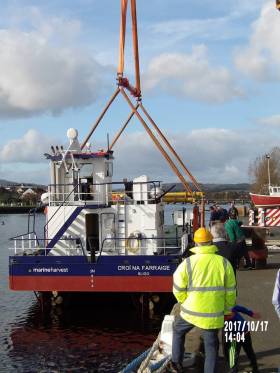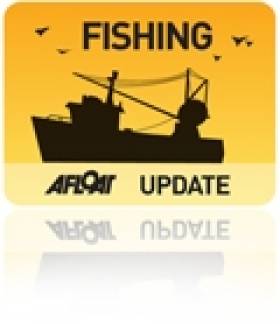Displaying items by tag: Marine Harvest Ireland
New 'Heart of the Sea' Salmon Harvesting Work-Boat Takes to the Water
#Newbuild - A mobile crane has lowered a new workboat into the River Avoca in Arklow this week for Ireland's largest producer of farmed Atlantic salmon, writes Jehan Ashmore.
The newbuild constructed by Arklow Marine Services is the Croi na Farraige (Heart of the Sea), a 17.5m salmon farm harvesting vessel for clients Marine Harvest Ireland. Staff from the company were invited to name the new vessel though a competition.
Croi na Farraige was transferred from the AMS building hall to the nearby North Quay of the Co. Wicklow port. It was from the quayside that the flat bottomed hull craft first made contact with the water.
The newbuild is equipped with a hydraulic crane mounted on the bow and a deckhouse is located aft. It is from the stern that can be seen in the above photo that the vessel has a twin rudder and propellor arrangement. Also clearly to be seen is that the vessel's port of registry is Sligo.
Marine Harvest have several sea farms along the western seaboard. They are located on Lough Swilly, Mulroy Bay, Inver Bay, Clew Bay, Kenmare Bay and Bantry Bay. All of the fish from these farms are packed at the firms Co. Donegal factory in Rinmore on the Fanad peninsula.
Croi na Farraige, will be used to support those sea-farms in Donegal waters from where Marine Harvest was founded by Irish investors in 1979.
MHI is part of the Marine Harvest Group with heaquarters in Norway, and is one of the world's leading seafood companies and the world's largest producer of Atlantic salmon. The global aquaculture operation employs 12,500 throughout 24 countries and servicing 70 markets.
High Levels of Sea Lice Detected at Irish Salmon Farms
#FishFarm - Two Irish fish farms were found to have consistently high levels of sea lice over the past six months, according to new figures.
Undercurrent News reports on findings by the Marine Institute which show that a farm owned by Marine Harvest Ireland at Lough Swilly and one operated by the Mannin Bay Salmon Company in Corhounagh were "found to have levels of sea lice which exceed the Marine Institute's protocol level of two pregnant female lice per fish."
Sea lice levels at the Lough Swilly site in particular climbed from an average of 4.35 per fish to a high of 71.72 in September before dropping to a still-high 44.88 last month.
A statement issued by Marine Harvest played down concerns over the new figures, noting that "treatment trigger levels are set a low level" in Ireland compared to other countries, and that it uses "tried and tested procedures" to deal with such infestations.
It added that lice numbers can rise and fall in tandem with changes in climate, as experienced in the latter months of 2012.
As reported on Afloat.ie last month, a new international study says some 39% of salmon mortalities can be attributed to the impact of sea lice - predominantly from fish farms - on wild salmon fisheries.
In a press release, Don Staniford of lobby group the Global Alliance Against Industrial Aquaculture (GAAIA) said: “The Irish Government should be controlling sea lice infestation on salmon farms not promoting even bigger feedlots such as the proposed 15,000-metric-ton farm in Galway Bay.”
Undercurrent News has more on the story HERE.






























































